
保护本土野生蜂巢穴生境(图)
日期: 2017-03-20
新闻主题: 买房租房
来源: 朱朝东博客
2006年前后,和吴燕如先生讨论如何开展中国蜜蜂总科研究。吴燕如先生提到中国油茶传粉的问题以及他们80年代对这些问题的研究情况。当时,我结合和Terry Griswold博士等申请FAO的传粉昆虫项目,对蜜蜂进行了一点调研,但对油茶传粉毫无概念。回国以后,在香山科学会议办公室杨老师的联络下,江西青龙集团和我们取得了联系,并支持我们在江西宜春油茶基地开展相关研究工作。当时,丁亮(科研助理)和黄敦元(合作培养硕士研究生)一起,在油茶基地蹲点,从传粉蜂多样性调查起步,逐步深入研究到优势传粉蜂的生活史。
通过实地了解和研讨会,我们了解到油茶在湖南、江西、广西等地非常普遍,相关企业也比较发达。但是,油茶产量一直难以提升。企业通过建立油茶种植基地,引进优良品种,对林地开展精细耕作等,期望提高油茶产出。油茶开花时节基本在国庆节后。这时的大部分昆虫种类和数量下降。油茶繁殖缺乏必要的传粉蜂,可能导致授粉不足。通过蹲点,课题组成员很快发现宜春当地油茶的野生传粉蜂的物种。同时,
我们很快发现这里存在一个现象:山地、基地和村边油茶林的传粉蜂数量明显不同。山地和村边少有人工管理,油茶林均有巢穴;而基地则由于除草剂和其它耕作措施,导致地面板结,很少巢穴。后续通过“考古式”挖掘,课题组才有油茶地蜂生活史的研究发现。这种油茶优势传粉蜂在地下筑巢深达1米以上,并沿主道挖出数个巢室。

林中生境
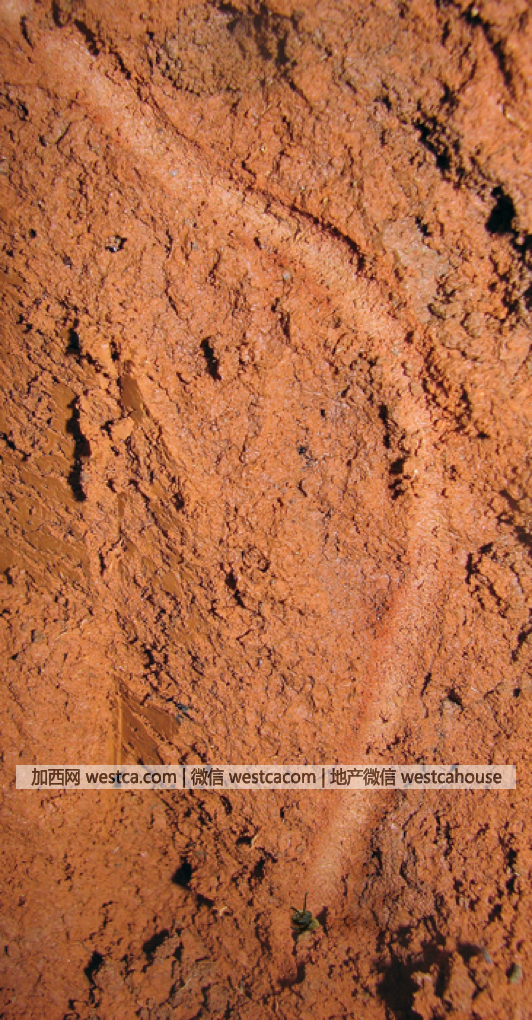
挖掘中的蜂巢(注意下部的传粉蜂)
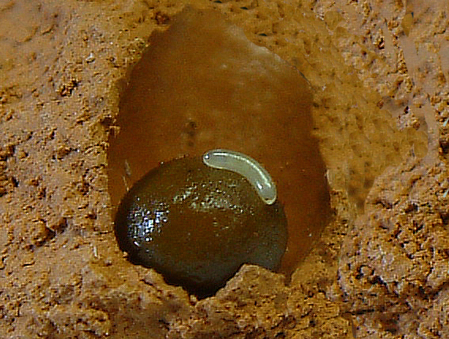
巢室中的蜂粮和地蜂幼虫
尽管大部分(>70%)的野生传粉蜂在土壤中筑巢,还有其它的具有不同的筑巢习性。研究和了解它们的筑巢习性,我们才能有针对性地保护生境,为它们构筑“安乐窝”提供相应的便利条件。
Bring Back the Pollinators: 5 Ways to Increase Nesting Habitat for Native Bees
【注】更加详细的信息见文后链接。
Recent research suggests that pollinators do better in urban environments, yet these mowed, mulched, and managed landscapes frequently lack a sufficient amount of nesting habitat needed to support large numbers of bees. As wild bees move off ag lands and head for the cities and suburbs, they may struggle to find their “dream home” amongst ours.
Birds do it. Bees do it.
Like birds, bees lay eggs in nests. Some even “feather” their nests with plant material or the fluff from downy leaves. 70% of bees nest in tunnels in bare earth, 30% lay their eggs in cavities – holes in dead wood, hollow stems, or even cracks in concrete or stone (only honey bees form hives.)
Both ground nesting and cavity nesting bees create a ball from pollen and nectar on which they deposit an egg in a “bee nursery” known as a brood chamber. Ground nesting bees form tunnels in the ground with multiple brood chambers. Cavity nesting bees find an existing tunnel in the form of a hole in dead wood or the hollow stems of certain plants. They create brood chambers starting at the back of the tunnel and working their way to the front, sealing each chamber as they go with mud or bits of plant material.
Bumblebee species nest in small colonies where multiple queens attend to the nest. They usually build their nest in dry, protected and hidden cavities below ground, such as an abandoned rodent burrow, under piles of wood or brush, under sheds or sometimes in old birdhouses.
When we keep a clean and tidy garden, we’re frequently eliminating natural materials and features that would otherwise provide nesting habitat for bees and other insects. It may sound too good to be true – but here are some ways you can provide much needed habitat for bees and other insects while saving time, money, and energy.
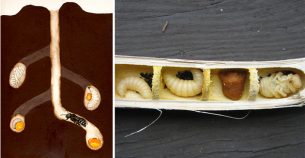
Illustration (left, Sarina Jepsen) showing ground nesting bees. Photo (right, Katharina Ullman) showing cavity nesting bees in a hollow stem.
Mulch less, mulch different
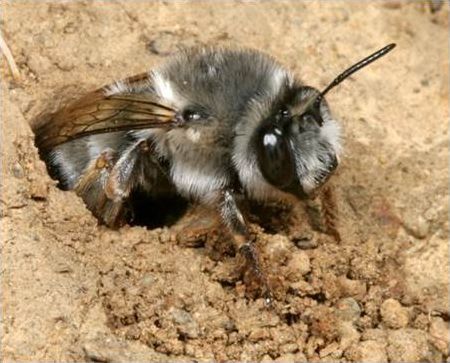
70% of bees are ground nesting, such as the mining bee shown here. They need access to bare ground uncovered by mulch. Photo Rollin Coville Photo: Rollin Coville
70% of native bees nest in the ground. Frequently when the words “ground nesting” are mentioned, the natural reaction is to think of wasps, who have a bad reputation as ground nesting insects. Unlike ground nesting wasps, who will form hives in abandoned rodent burrows and larger underground cavities, native ground nesting bees form small, non-aggressive colonies. Ground nesting bees, such as the mining bee shown at right, are some of the earliest pollinators to emerge in spring, making them vital to pollination of fruit trees such as cherries, plums, and apricots, as well as other flowering trees, shrubs, and spring ephemerals. When it comes to ground nesting bees, access to bare ground is essential, and even a 1-inch layer of mulch can be as impenetrable as pavement to these small bees.
People mulch for many reasons; to suppress weeds, prevent erosion, and because they feel it provides a clean aesthetic. If you must mulch, consider using compost or shredded leaves instead of chipped wood products. These alternatives will have the same weed suppression, water retention, and other properties – yet be light enough to allow ground nesting bees to pass through. Additionally they release nutrients and provide organic matter that actually improves your soil quality! Also consider mulching just the parts you see. It’s often sufficient to mulch just the first two feet or so into a bed, leaving areas in the back uncovered to allow access for pollinators.

The pithy stem of a raspberry cane may be used by cavity nesting pollinators. Photo: Jennifer Hopwood
Grow raspberries…
..and other plants with pithy or hollow stems such as Joe Pye weed (Eutrochium spp.), elderberry (Sambucus spp.), hydrangea, and others. Cavity nesting bees will make nests in the dried stems and twigs from previous years’ growth, so don’t aggressively cut back or clean up these plants and consider leaving dead branches alone. Other invasive plants such as bamboo, Japanese knotweed, and teasel should not be planted, but bundles of stems from these plants can serve as valuable nesting material (more on that below).
Don’t forget the grasses, too! While we often skip grasses for showy flowers, native bunch grasses, such as switchgrass (Panicum spp.), indian grass (Sorghastrum nutans), prairie dropseed (Sporobolus heterolepsis), little bluestem (Schizachyrium scoparium), big bluestem (Andropogon geradii), and grama grass (Bouteloua spp.) provide nesting sites and protection for bumble bee queens to overwinter. Many of these grasses do double duty, serving as butterfly host plants as well.
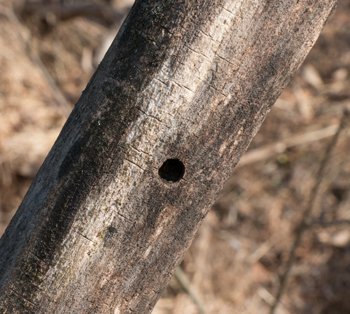
This perfectly round hole in the dead branch of a tree was likely made by a cavity nesting bee. Photo: Justin Wheeler
Save a (dead) tree or “plant” a log
Maybe it’s a reminder of our own mortality, but when we see a dead tree or even a dead branch, our first impulse is often “that’s gotta go!” In many cases this material poses no real danger, and, if it can be tolerated, this dead woody material provides an abundance of habitat for all sorts of wildlife. Beetles and carpenter ants burrow into dead wood, birds go after these insect treats, and this activity creates perfect chambers for cavity nesting bees to lay their eggs. While you may not want to gaze lovingly upon a dead tree from your kitchen window over morning coffee, you can add this valuable habitat to your landscape by leaving piles of twigs, branches, or logs in your garden.
Build a better brush pile
The very mention of a brush pile conjures up such nightmarish images (fire! snakes!) that the idea of adding one to your carefully cultivated landscape may seem anathema. Yet adding a brush pile is one of the most effective ways you can provide habitat for a diversity of wildlife while also benefiting the environment and saving money in the long-term.
In most municipalities, local waste management authorities will collect curbside brush and either chip it and compost it or haul it off to a landfill. In both cases, you’re paying for this service in your trash bill. If everyone retained just a small amount of their clippings and pruned branches we could reduce the burden on our waste management system. More to the point however, small mammals will also make use of a brush pile, creating burrows that later provide space for bumble bees to nest. Brush piles also provide cover for other ground nesting bees, and provide food for many other invertebrates who eventually break the piles down into valuable organic matter for your garden.
Worried about it being an eyesore? Get creative and build a “brush fence”, hide the pile behind ornamental grasses, or simply install a Pollinator Friendly Habitat sign to advertise your good intentions to your neighbors.
Bee houses

While bee hotels can be attractive additions to your garden, they need to contain the right materials and be easy to clean or replace – otherwise they may do more harm than good. These bee hotels by Marta Zientek use natural materials, others use man-made paper tubes.
In recent years the concept of “bee houses” have gained popularity, with many D.I.Y. versions popping up on Pinterest and commercially available versions appearing in gardening catalogs. These artificial nesting structures are meant to support mason bees, leafcutter bees, and other cavity nesters.

A “bee hotel” can be as simple as a bundle of cut bamboo stems. Once bees emerge these stems should be discarded and replaced to prevent disease. Photo: Mace Vaughan
Some use cuts of bamboo, others cardboard tubes. Many are elaborate and quite beautiful – but the efficacy of these structures varies widely. Building a bee hotel can be a fun, crafty, D.I.Y. adventure, and provide valuable nesting habitat, but when not properly maintained these structures become a sponge for pathogens and mites which build up in the nesting material over time. If choosing to design and build or purchase a man-made bee hotel, just be aware it’s not a “set it and forget it” proposition.
One of the easiest ways to create a “bee hotel” with minimal effort and maintenance is simply to bundle cuts of bamboo or other hollow or pithy stems that are closed at one end (bees will not lay eggs in cavities open at both sides) and hang them in a sheltered location. If possible, orient the material so it’s facing southeast so it will be warmed by the morning sun. Bamboo, Japanese knotweed, and teasel all provide excellent material for this purpose. Often you can cut just behind the node (raised bumpy part of the stem) to create a perfect tunnel. Hang your bundle beneath a roof overhang or other sheltered location or place them in a bucket laid on its side. (For complete details and instructions checkout our fact sheet Tunnel Nests for Native Bees.) Whatever material you use, be sure to replace it every other year to destroy any pathogens or mites that may have also taken up residence in the material. A good plan is to make a new nest over the winter each year and hang it next to the old one. Once the bees have emerged in spring, remove and discard the old material.
Bringing it all together
In this illustration we show how a well designed garden can include many opportunities to provide nesting habitat as landscape features.

Source: USDA
Resources
Fact Sheet: Nests for Native Bees
Fact Sheet: Tunnel Nests for Native Bees
Enhancing Nest Sites for Native Bee Crop Pollinators
Written by Justin Wheeler, Web and Communications Specialist
|
|